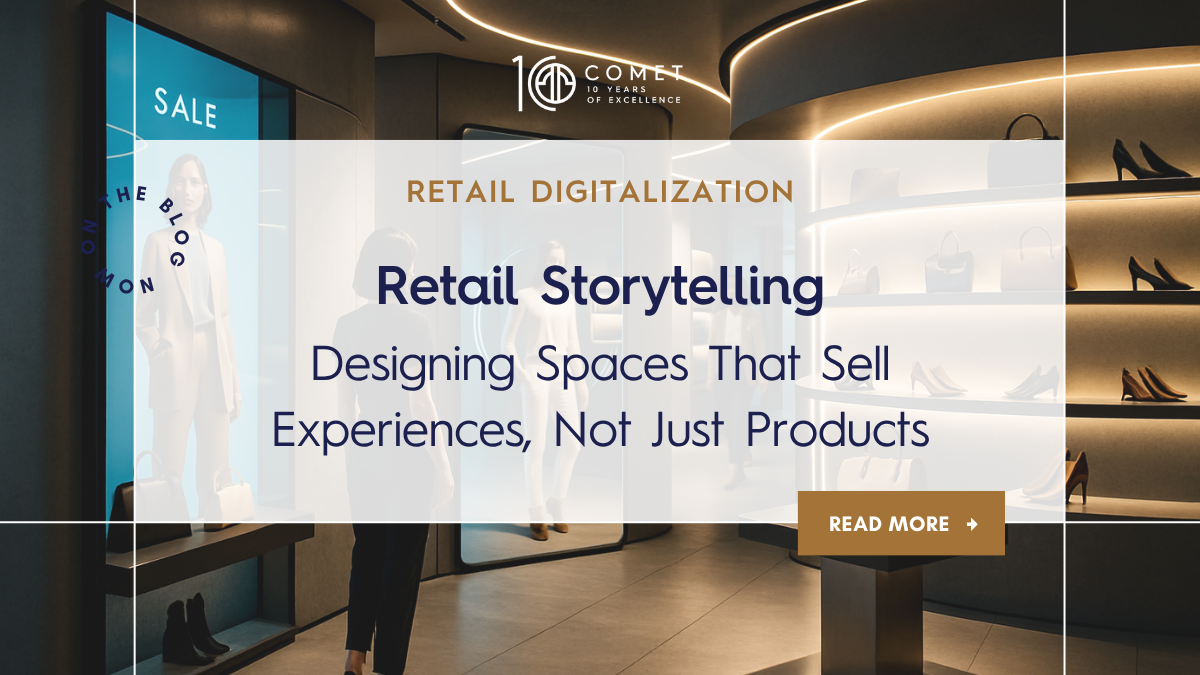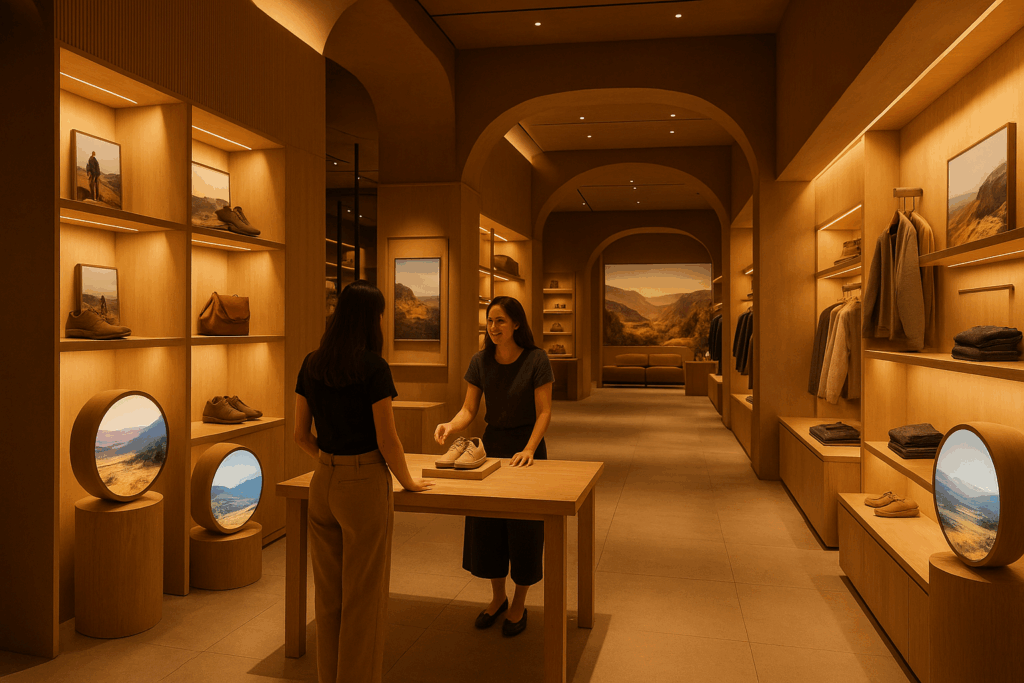
Retail Storytelling: Designing Spaces That Sell Experiences, Not Just Products
In 2025, retail isn’t just about transactions — it’s about transformation.
The most successful brands are those that turn every visit into a story, every corner into a moment, and every detail into an experience.
At Comet Architects + Interiors, we see retail design as more than just arranging shelves and lighting products — it’s about shaping emotional connections. Because in an age where customers can buy anything online, what brings them into a physical space is how that space makes them feel.
From Storefronts to Storytelling
The new era of retail design blends architecture, technology, and psychology. Shoppers today expect more than efficiency — they expect immersion.
A well-designed retail space no longer says, “We sell products.” It says, “We understand you.”
It tells a story of craftsmanship, values, and belonging — and that story unfolds through textures, movement, light, and layout.
A study by the Retail Design Institute shows that 84% of customers are more likely to return to stores that provide an engaging sensory experience.
That’s what retail storytelling does — it transforms ordinary spaces into brand experiences.
1. The Power of First Impressions
The journey begins the moment someone walks through the door.
The entrance sets the tone — not just for the space, but for the brand itself. It’s where emotion meets design.
- Lighting acts as the first narrative cue — soft lighting feels warm and exclusive, while bright, focused lighting creates energy and vibrancy.
- Material selection — natural wood, glass, stone, or metal — communicates authenticity, luxury, or innovation.
- Spatial rhythm — how a visitor moves from one zone to another — defines how the story unfolds.
At Comet, we design entrances that don’t just welcome — they intrigue. They invite customers into a journey that feels intentional and emotionally guided.
2. Designing for the Senses
Every memorable retail experience is multisensory.
Shoppers remember how a space looked, felt, sounded, and even smelled.
Think of a boutique where soft textures meet ambient soundscapes.
Or a tech store where sleek surfaces and precise lighting amplify innovation.
Each sense reinforces the brand identity — building an emotional bond that drives loyalty.
Data backs it up: 63% of consumers say sensory elements influence how long they stay in-store, and 42% say it directly impacts their purchase decisions.
At Comet, we create immersive spatial storytelling — through color, acoustics, and tactility — to turn brand values into design language.
3. Layouts That Guide Behavior
Retail storytelling is also about movement — how customers flow, pause, and interact with the space.
- Zoning helps define moments — display zones, try zones, interaction zones, and quiet corners.
- Sightlines guide curiosity — what’s visible from the entrance, what’s revealed gradually.
- Circulation shapes engagement — whether you want visitors to explore freely or follow a curated path.
For example, circular layouts encourage exploration, while linear ones build anticipation.
When the layout aligns with shopper psychology, sales rise — by as much as 30%, according to NielsenIQ.
That’s why at Comet, we treat space planning as strategic storytelling. Every angle, path, and focal point carries purpose.
4. Technology as the Silent Storyteller

In today’s world, digital integration is no longer optional — it’s essential.
But the secret isn’t in adding more screens; it’s about adding meaning through technology.
From AR mirrors that personalize experiences to smart lighting systems that adapt to visitor flow — tech enables brands to tell their stories in real time.
Smart analytics also track movement patterns, helping retailers understand behavior and continuously refine design.
At Comet, we integrate technology not as a layer — but as part of the architectural DNA of the space.
Because when digital and physical blend seamlessly, storytelling becomes dynamic — constantly evolving with every visitor.
5. The Emotional ROI of Design
Great retail design doesn’t just look good — it performs.
When done strategically, design boosts both customer retention and sales performance.
- Customers spend up to 40% longer in well-zoned, comfortable spaces.
- Emotionally engaged shoppers are 3x more likely to recommend a brand.
- And every dollar invested in experience-driven design yields an average return of $7, according to recent global retail research.
That’s what we call design ROI — the measurable impact of emotional connection, functionality, and beauty working together.
6. Retail as a Reflection of Culture
Retail spaces don’t exist in isolation — they mirror culture, aspiration, and identity.
In the MENA region, this is especially powerful.
Consumers value authenticity — spaces that blend global sophistication with local craft.
They seek environments that reflect heritage while embracing innovation.
At Comet, we approach every project with this duality in mind — balancing modern elegance with regional identity.
Whether it’s a flagship store or a boutique retail experience, we design spaces that speak the language of their audience — visually, emotionally, and spatially.
7. Case Insight: Turning Space into Experience
One of our recent retail collaborations illustrates this perfectly.
Instead of focusing on product display, we focused on customer journey mapping — understanding the emotional peaks and pauses in each visit.
We redefined layout, introduced flexible lighting zones, and crafted materials that invite touch and interaction.
The result?
A space where customers didn’t just buy — they belonged.
Sales increased, dwell time doubled, and post-visit satisfaction scores soared.
That’s the true power of storytelling in retail — turning a space into a brand ecosystem.
8. The Future of Retail Design
Looking ahead, retail spaces will continue evolving from static environments into living experiences.
Expect:
- Adaptive architecture — layouts that evolve based on real-time data.
- Personalized spatial journeys — where design responds to mood or behavior.
- Sustainability-driven aesthetics — using reclaimed, natural, or renewable materials without compromising elegance.
At Comet, we see this not as a trend — but as the future of meaningful retail design.
Spaces that engage hearts before they sell products.
Because the most powerful brand message isn’t written — it’s designed.
Every Detail Tells a Story
Retail storytelling is about more than just creating beauty — it’s about creating belief.
Every color, every curve, and every light source tells a part of your brand’s story.
At Comet Architects + Interiors, we design with purpose — helping brands transform their spaces into experiences that inspire, connect, and convert.
Ready to transform your retail space?
Let’s turn your brand story into a living, breathing experience.
📩 Contact us today or visit cometarch.com to explore how our team can help you design spaces that sell more than products — they sell emotion.
